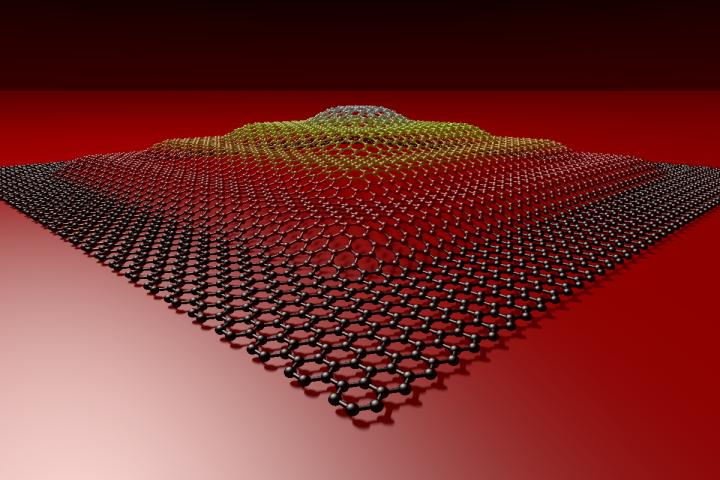Graphene forged into three-dimensional shapes

A similar structure was made experimentally by using laser irradiation in a process called "optical forging." Credit: The University of Jyväskylä
Graphene is a close relative to graphite, which consists of millions of layers of graphene and can be found in common pencil tips. After graphene was first isolated in 2004, researchers have learned to routinely produce and handle it. Graphene can be used to make electronic and optoelectronic devices, such as transistors, photodetectors and sensors. In future, we will probably see an increasing number of products containing graphene.
“We call this technique optical forging, since the process resembles forging metals into 3D shapes with a hammer. In our case, a laser beam is the hammer that forges graphene into 3D shapes,” explains Professor Mika Pettersson, who led the experimental team at the Nanoscience Center of the University of Jyväskylä, Finland.
“The beauty of the technique is that it's fast and easy to use; it doesn't require any additional chemicals or processing. Despite the simplicity of the technique, we were very surprised initially when we observed that the laser beam induced such substantial changes on graphene. It took a while to understand what was happening.”
“At first, we were flabbergasted. The experimental data simply made no sense,” says Dr Pekka Koskinen, who was responsible for the theory. “But gradually, by close interplay between experiments and computer simulations, the actuality of 3D shapes and their formation mechanism started to become clear.”
“When we first examined the irradiated graphene, we were expecting to find traces of chemical species incorporated into the graphene, but we couldn't find any. After some more careful inspections, we concluded that it must be purely structural defects, rather than chemical doping, that are responsible for such dramatic changes on graphene,” explains Associate Professor Wei Yen Woon from Taiwan, who led the experimental group that carried out X-ray photoelectron spectroscopy at the synchrotron facility.
The novel 3D graphene is stable and it has electronic and optical properties that differ from normal 2D graphene. Optically forged graphene can help in fabricating 3D architectures for graphene-based devices.
###
The research was carried out at the Nanoscience Center (NSC) of the University of Jyväskylä, the National Central University of Taiwan and the National Synchrotron Radiation Research Center in Taiwan.
Inquiries
- Professor Mika Pettersson, tel. +358 50 310 9969, mika.j.pettersson@jyu.fi
- Associate Professor Wei Yen Woon, tel. +886 927 374 826, wywoon@phy.ncu.edu.tw
Reference
Andreas Johansson, Pasi Myllyperkiö, Pekka Koskinen, Jukka Aumanen, Juha Tapio Koivistoinen, Hung-Chieh Tsai, Chia-Hao Chen, Lo-Yueh Chang, Vesa-Matti Hiltunen, Jyrki Manninen, Wei-Yen Woon, and Mika Pettersson, Optical Forging of Graphene into Three-Dimensional Shapes. Nano Lett., DOI: 10.1021/acs.nanolett.7b03530 http://pubs.
Photo: A pyramid made from graphene. A similar structure was made experimentally by using laser irradiation in a process called 'optical forging'.
Press contact:
Academy of Finland Communications
Communications Specialist Leena Vähäkylä
tel. +358 295 335 139
firstname.lastname(at)aka.fi
Media Contact
More Information:
http://pubs.acs.org/doi/10.1021/acs.nanolett.7b03530All latest news from the category: Materials Sciences
Materials management deals with the research, development, manufacturing and processing of raw and industrial materials. Key aspects here are biological and medical issues, which play an increasingly important role in this field.
innovations-report offers in-depth articles related to the development and application of materials and the structure and properties of new materials.
Newest articles

Innovative vortex beam technology
…unleashes ultra-secure, high-capacity data transmission. Scientists have developed a breakthrough optical technology that could dramatically enhance the capacity and security of data transmission (Fig. 1). By utilizing a new type…

Tiny dancers: Scientists synchronise bacterial motion
Researchers at TU Delft have discovered that E. coli bacteria can synchronise their movements, creating order in seemingly random biological systems. By trapping individual bacteria in micro-engineered circular cavities and…

Primary investigation on ram-rotor detonation engine
Detonation is a supersonic combustion wave, characterized by a shock wave driven by the energy release from closely coupled chemical reactions. It is a typical form of pressure gain combustion,…



